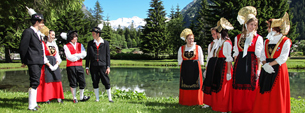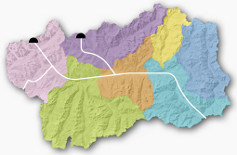Wood
Valle d'Aosta craftwork started out as a simple art, an expression of a world of important values, a love for order, one's family and traditions. Every item, in its uniqueness, carried with it the expressive strength of a civilisation that faced life calmly and with stability, reflecting an historical moment when time moved more slowly and every aspect of human life took on great importance.
The materials used were those easily found locally: first and foremost was wood.
The typical mountain residences and rural homes were generally built mainly with wood and stone, making the most of ingenious methods of joints between the beams, to avoid using nails. The houses were simple, basic constructions with small windows and limited empty spaces: while being simple, the home was still capable of fully meeting the families' basic needs, ensuring protection from bad weather in the cold season (with a minimum heat loss) and protection for livestock, as well as the preservation of food products in their specific holds.
Houses in Valle d'Aosta were built to last over time: walls were thick, capable of keeping out the summer heat and preventing heat loss in winter; they had a solid roof, based on large beams and covered in stone plates (normally slate) lying one on top of the other.
Furniture was simple and practical; it was normally made with walnut wood and, therefore, was heavy and solid. Even in this sector, the aesthetic aspects were not ignored, and this is why the various items of furniture were frequently decorated with various kinds of decorations. The items of furniture most commonly found in the room where most of daily life was carried out were the dresser, chest and large table: this kind of set up nowadays is used to furnish the so called "tavern", rooms normally created on the ground floor of a house where one can welcome friends and spend evenings together. In this large kitchen, the bread ratelé is an essential item, a base that supports the rye bread and helps it dry.
Some of the most important household tools still in use today include chopping boards often decorated with rosettes, like the characteristic coppapan (complete with knife that is used to crack black bread), and labels for the butter and bread. One item particularly dear to families and still kept with affection was the cradle for newborn babies. Lastly, shaving tools were very unusual and nowadays highly sought after because they are almost impossible to find: they include a piece of furniture with glory hole and sliding mirror cover.



















